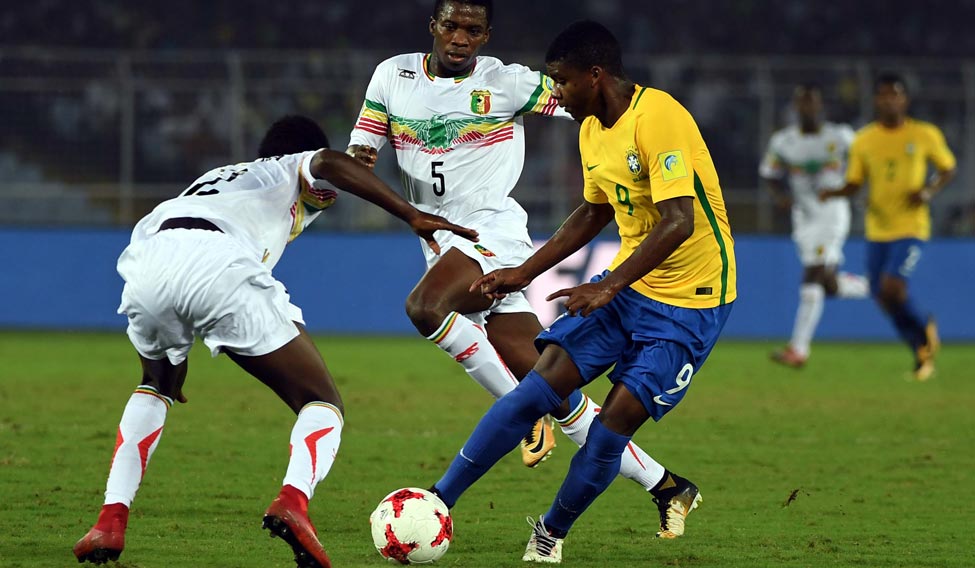Many are unaware but in 1950 India had qualified for the World Cup in Brazil but for a concatenation of several reasons, playing barefoot being one of them, declined to participate. That opportunity was lost but 67 years later in October 2017, Indian football made its tryst with destiny, when they hosted the U-17 World Cup. India became the fifth Asian country after China, Japan, South Korea and UAE to host the U-17 World Cup. The other Asian nations built on the momentum of having hosted a global football event and have all made the senior World Cup finals at least once. Can India emulate them?
Staging the U-17 World Cup in six different cities has certainly upgraded the infrastructure in the country, in terms of stadiums and practice pitches. It has increased interest in Indian football and altered perceptions about the game in the country. Some of the legacies of hosting the U-17 World Cup are tangible and some intangible. It is up to the All India Football Federation (AIFF) to build on these legacies.
The most tangible benefit is that six world class all-seater stadiums are ready in six different states. Above all, personnel have been trained to ensure that the playing surface and infrastructure is well maintained. An example of this is the music concert held by Salman Khan at the Jawaharlal Nehru Stadium, Delhi, in the second week of December 2017. An ISL match between hosts Delhi Dynamos and FC Goa was to be staged on December 16. There was apprehension that the ground would not be ready for the match. However, the trained personnel ensured minimum damage and got the ground in shape for the match.
The other benefit of having world class stadia in the country is that leading European clubs like Real Madrid, Barcelona, Chelsea, Manchester United, Manchester City and Arsenal can now play in one of the six cities in their pre-season summer tours. These clubs come to Japan, China, Malaysia and Singapore but can now include India as the playing facilities are world class. This could lead to long term TV and merchandising deals. The Vivekananda Yuba Bharati Krirangan (Salt Lake stadium) in Kolkata is also aesthetically pleasing. Javier Ceppi, the Local Organising Committee (LOC) tournament director feels this stadium can rank among the best in Asia and can stage any international match.
India shattered the record for largest attendance at the U-17 World Cup, with 13,47,143 spectators attending the event. This was the greatest legacy for Indian football as it showed that the country is not just cricket obsessed and there are passionate fans for other sports also. FIFA President Gianni Infantino, who attended the final along with other FIFA executive members, was very impressed. He and Ceppi both feel that in about two decades football can become the number one sport in India, as the passion for the game among the younger generation is immense.
The Indian team’s involvement in the World Cup lasted only one week. They played gallantly in the Group A matches against superior opposition, lost 0-3 to USA, 1-2 to Colombia and 0-4 to Ghana. They captured the public imagination and the players became household names and received adulation from the fans and got ample media exposure. For nearly one week, from October 6-12, the U-17 Indian football team got extensive media coverage. Their hobbies, their football heroes (Cristiano Ronaldo was the most popular with seven of the Indian squad listing him as their icon) and the clubs they supported (Real Madrid was the team of choice, with 12 saying they backed the current European and La Liga champions and only four supported Barcelona) were all written about.
Spectators at the Jawaharlal Nehru Stadium, Delhi, chanted the names of their heroes, goalkeeper Dheeraj Moirangthem, Anwar Ali, Boris Thangjam, Jitendra Singh, and the six foot-tall goal scorer, Jeakson Thounaojam. A product of the Minerva Football Academy, Punjab, Jeakson headed in a corner kick against Colombia, the first and only goal scored by India in this tournament.
This extensive media coverage is both a tangible and intangible gain. More was known about Dheeraj than the goalkeeper of the senior team Gurpreet Singh Sandhu. Dheeraj, who initially loved playing badminton, was one of the finds of the tournament. His alertness under the bar kept the margin of defeat respectable. Scouts noted his excellent performances and he could go for trials to Motherwell, a Scottish premier league club in 2018.
An analysis of India’s U-17 squad revealed that they mostly are from humble backgrounds. Midfielder Abhijit Sarkar’s father pulls a rickshaw in Chinsurah, Bengal. Defender Anwar Ali’s father grazes cattle in Punjab and tenacious Jitendra Singh’s father is a watchman in new Alipore, Kolkata. Sanjeev Stalin’s mother sells clothes at a Bangalore footpath. The skipper’s parents sell fish in Imphal and midfielder Jeakson Singh has an ailing father and is dependent on his mother, a vegetable seller in the local market. Another midfielder from Manipur, Ninthoi lost his father in the summer of 2017 and lives in a two-room tin roofed shack. Only goalkeeper Dheeraj Singh and midfielder Suresh Singh and the two overseas recruits, Sunny Dhaliwal (Canada) and Namit Deshpande (USA) were from middle-class families.
The intangible benefit is that the extensive media coverage and positive display by the Indian team probably inspired many youngsters watching these games to actively take part in football. Now it is up to the AIFF to capitalise on the massive goodwill created by hosting the U-17 World Cup.
Creditably, the Indian team well coached by Luis Norton de Matos did not get overawed and created a positive impression. Their gallant displays aroused optimism for the future, which is yet another positive legacy. Several of the U-17 team got selected for the Asian U-19 qualifiers in Saudi Arabia in November 2017. Nearly all of them are playing for the Indian Arrows team in the ongoing 11th Hero I-League.
To ensure continuity, the AIFF offered the entire squad contracts for two years, with a monthly salary of Rs 50,000. Also, this is imperative as many I-League do not have proper age group teams and also there are limited competitions for them. Hence, to ensure that the players do not wither away or spend years as reserves in some ISL franchise or I-League club, the AIFF decided to develop the Indian Arrows squad that is taking part in the 11th I-League. Some U-19 players were also included in this team. The Portuguese Luis Norton is the chief coach and he is assisted by the Mumbai-based Floyd Pinto, who was looking after the U-19 team.
The U-17 World Cup also revealed that Indian children are being exposed to football training and competitive matches much later than in developed football nations. Creditably, steps are being taken to rectify this. The AIFF has started the U-13, U-15 and U-18 leagues in the country. To develop Indian football serious efforts have to be taken by the AIFF and existing clubs. Hopefully, the FIFA U-17 World Cup in October 2017 is a wake-up call to implement schemes that can build for the future.











